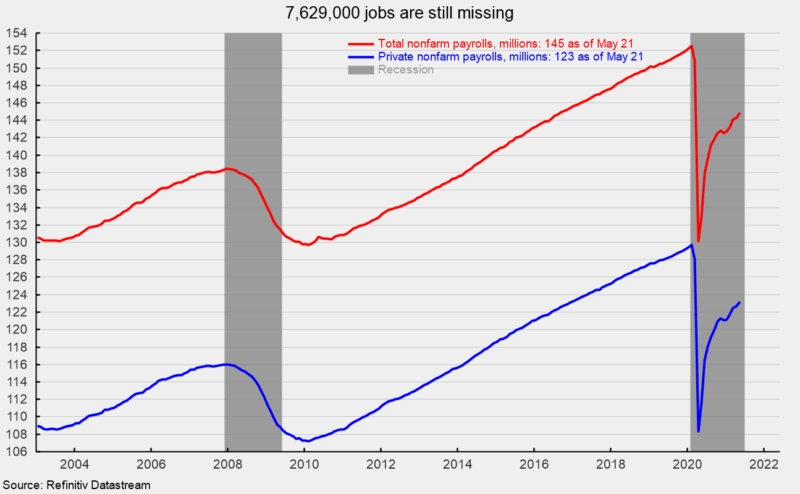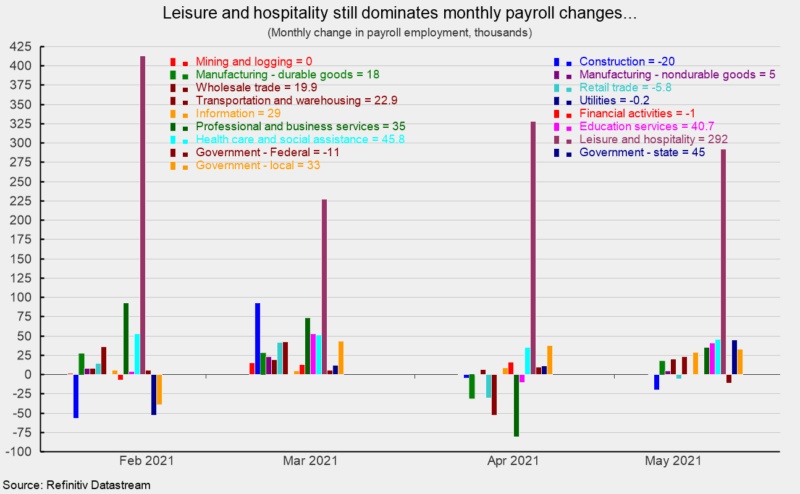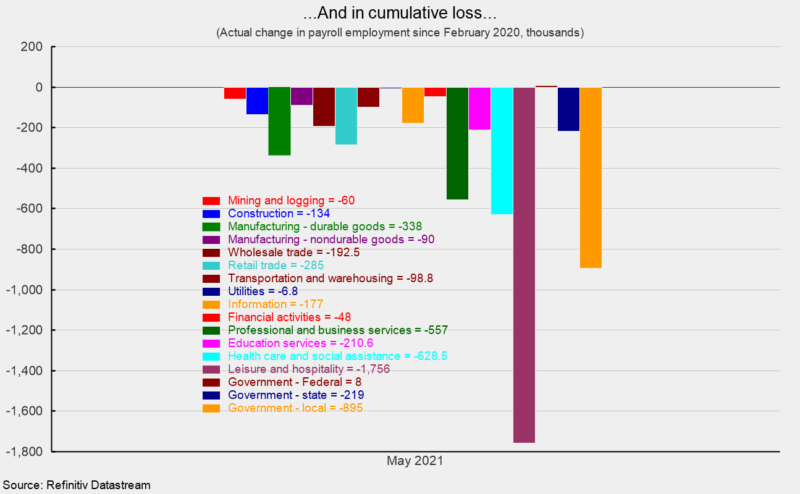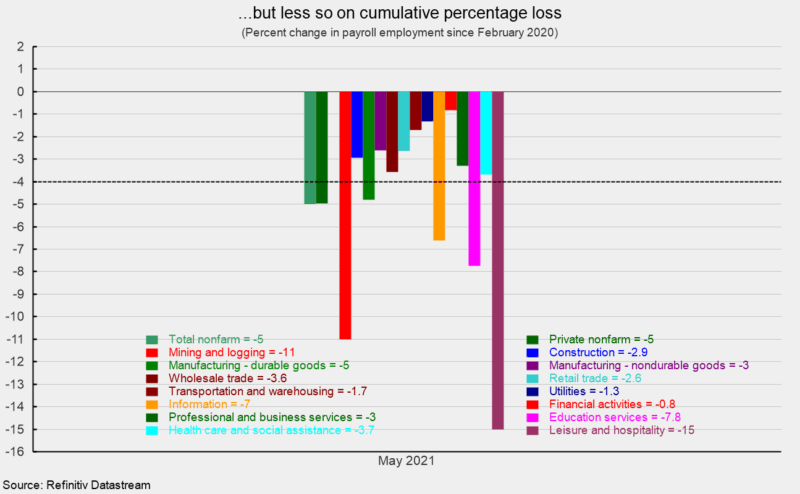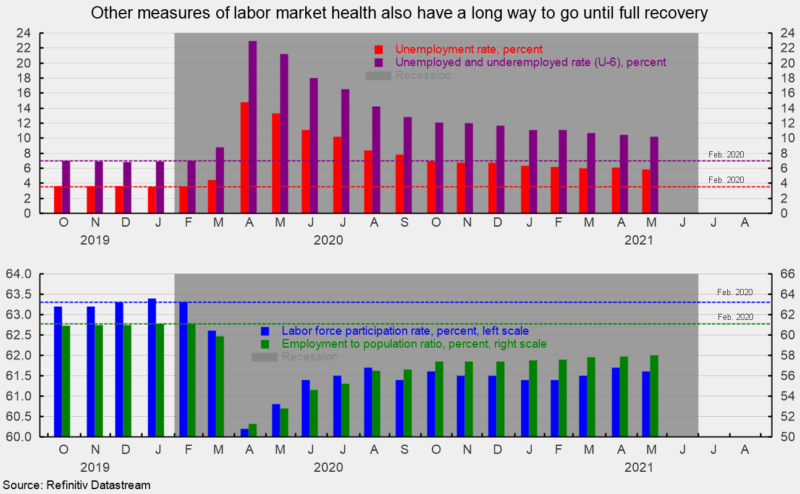U.S. Economy Adds 559,000 Jobs in May
U.S. nonfarm payrolls added 559,000 jobs in May after a gain of 278,000 in April. March and April had net upward revisions of 27,000. The May gain is the fifth in a row and 12th in the last 13 months, bringing the five-month gain to 2.391 million and the 13-month post-plunge recovery to 14.733 million, but is still well below the 22.362 million loss in March and April of 2020, leaving nonfarm payrolls 7.629 million below the February 2020 peak (see first chart).
Private payrolls posted a 492,000 jobs gain in May after a 219,000 gain in April. The two prior months had a net upward revision of 17,000. The May rise in private payrolls is also the fifth in a row and 12th in the last 13 months. May brings the five-month gain to 2.179 million and the 13-month recovery to 14.891 million versus a loss of 21.353 million in March and April of 2020, leaving private payrolls 6.462 million below the February 2020 peak (see first chart).
Breadth of gains for May was positive. Within the 492,000 gain in private payrolls, private services added 489,000 while goods-producing industries added 3,000. For private service-producing industries, the gains were led by a 292,000 surge in leisure and hospitality (following gains of 328,000 in April, 227,000 in March, and 413,000 in February), a 46,000 gain in health care and social assistance, 41,000 in education, a 35,000 rise in business and professional services, 29,000 new employees in information services, and 23,000 additional transportation and warehousing employees (see second chart).
Within the 3,000 gain in goods-producing industries, construction was down 20,000, durable-goods manufacturing increased by 18,000, nondurable-goods manufacturing rose by 5,000, and mining and logging industries were unchanged (see second chart).
Despite the ongoing recovery, every private industry group still has fewer employees than before the government lockdowns. Leisure and hospitality leads with a loss of 1.756 million jobs followed by health care, down 628,500, and professional and business services with a drop of 557,000 (see third chart).
On a percentage basis, the losses are more evenly distributed. Leisure and hospitality still leads with a 15.0 percent drop since February 2020, mining and logging comes in second with an 11.0 percent loss followed by education services at 7.8 percent and information services at 7.0 percent. Five of the 14 private industries shown in the report have declines of 4 percent or more since February 2020. For the labor market as a whole, total nonfarm payrolls and private payrolls are down 5 percent since February 2020 (see fourth chart).
The government sector added 67,000 employees in May, with local government payrolls rising by 33,000, state government payrolls up 45,000, and the federal government cutting 11,000 workers.
Average hourly earnings rose 0.5 percent in May, putting the 12-month gain at 2.0 percent. The average hourly earnings data should be interpreted carefully, as the concentration of job losses for lower-paying jobs during the pandemic distorts the aggregate number.
The average workweek was unchanged at 34.9 hours. Combining payrolls with hourly earnings and hours worked, the index of aggregate weekly payrolls gained 0.9 percent in May. The index is up 13.2 percent from a year ago.
The total number of officially unemployed fell to 9.316 million in May, a drop of 496,000 from April. The unemployment rate dropped to 5.8 percent while the underemployed rate, referred to as the U-6 rate, fell to 10.2 percent in May. In February 2020, the unemployment rate was 3.5 percent while the underemployment rate was 7.0 percent (see top of fifth chart).
The participation rate declined in May, coming in at 61.6 percent versus a participation rate of 63.3 percent in February 2020. The employment-to-population ratio, one of AIER’s Roughly Coincident indicators, came in at 58.0 for May, above the 57.9 ratio in April 2021 but well below the 61.1 percent in February 2020 (see bottom of fifth chart).
The May jobs report shows a solid gain in private payrolls, though the gain was largely attributable to the leisure and hospitality industry. Despite the fifth consecutive monthly gain, the labor market remains well below conditions from before the pandemic.
Other measures of economic activity generally suggest the economic recovery from the government lockdowns in 2020 is gaining momentum as the restrictions on consumers and businesses are lifted. However, the damage done by the lockdowns was severe. Not only is employment still below pre-pandemic levels, but fallout from financial burdens on small businesses that were shuttered, personal and business bankruptcies and/or increased debt burdens, and unraveling the moratoriums on evictions may still restrain future growth. Furthermore, the inability of supply to recover as quickly as demand is resulting in shortages in some areas of the economy and resulting in significant upward pressure on prices. The overall outlook is tilted to the upside, but fallout from the lockdowns linger.

